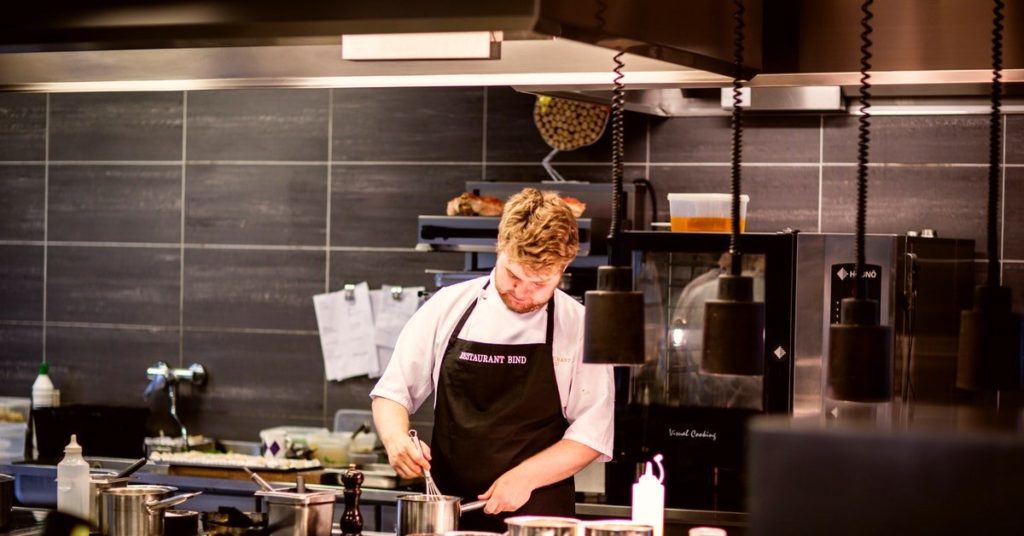Restaurant Food Safety: The 4 C’s

Estimated reading time: 8 minutes
Introduction
Restaurant food safety is outlined by the Food Standards Agency within the ‘Safer Food Better Business for Caterers’ document. The FSA centres all of their guidelines for food businesses around the 4 C’s of Food Hygiene: cross-contamination, cleaning, chilling and cooking.
In this article, we will consider how we can apply the 4 C’s within the restaurant environment.
Cross-Contamination
Cross-contamination is defined as the transfer of bacteria or other harmful microorganisms from an infected area to a non-infected area. The problem for restaurateurs and their staff is that, in a restaurant, the potential for cross-contamination is common.
Let’s consider where some of the places these microorganisms can emerge:
- Food Groups – Raw meats, leafy green vegetables, cooked rice; these are just a few of the common culprits which can carry bacteria throughout the kitchen. Poultry can harbour campylobacter and salmonella, leafy greens often host E. coli and clostridium and cooked rice can be a perfect breeding ground for bacillus cereus.

- Pests – Rats, mice and cockroaches can all be surprisingly common. All of these pests can carry harmful bacteria; rats often even carry leptospira bacteria, which can cause the potentially severe Weil’s disease. Consequently, your restaurant suffers a pest infestation, closure can be immediate and conclusive.
- Viruses – Viruses can also be common in food preparation, particularly if you don’t maintain good personal hygiene standards. Norovirus and rotavirus can cause severe gastroenteritis and are both transmissible through food preparation, if a carrier doesn’t wash their hands after going to the toilet.
- Physical and Chemical Contamination – Bleach, disinfectant and other cleaning materials can be dangerous sources of chemical contamination if they get into food. Similarly, broken glasses from the bar, broken plates and other various kitchen debris can all become problematic physical contamination in food.
Preventing Cross-Contamination
So, how can we move to prevent these forms of contamination from occurring?
Good hand washing is a necessity; transferring bacteria around the kitchen via the human hands is both easy and common. Wash your hands regularly with antibacterial soap, particularly after handling raw meats and other high-risk foods.

When it comes to the food groups, you should handle them all differently. Never wash raw meat; this is one of the most common food hygiene mistakes. You are more likely to contaminate surfaces if you wash raw chicken. The best method for killing bacteria on chicken is to cook it thoroughly. However, you should always wash vegetables to rid them of bacteria. We’ll mention cooked rice a little later on.
Dealing with pests is relatively simple. Clean your bins! Empty your bins properly, regularly and never leave them overnight. This isn’t a surefire way to prevent pest infestation but it’s a good start; cut off the food supply and the pests should be less interested in your kitchen.
When it comes to viruses, you can’t really control customers coming into your restaurant whilst carrying a foodborne virus. However, kitchen staff have control over the preparation of food. If you’re suffering from vomiting and diarrhoea and/or think you might have norovirus, don’t come into work until you are symptom-free for 48 hours. Hand-washing is of further help here.
Cleaning
In a fast-paced catering environment, thorough cleaning can be a challenge. However, it is vital to proper restaurant food safety. The best approach is to adopt a ‘Clean-as-You-Go’ policy. This involves both scheduled cleans and immediate cleans. Your team should divide responsibilities for these cleaning duties into a rota system. This ensures that the restaurant food safety is optimal before, during and after a shift.
Here’s a few more things to consider when cleaning your restaurant:
- How will you clean your dishes? – It may sound a little bit trivial but choosing the right method for washing dishes can really help. If you run a small restaurant which is moderately busy throughout the day, washing by hand could be a sensible, economic option. However, if you work in a larger, busier restaurant, your team may not have time to properly, safely clean dishes. A dishwasher and/or glasswasher are good ideas in this case; they are more efficient and often have a self-clean/descale cycle.
- How can you facilitate better food hygiene? – Good personal hygiene is important from top-to-bottom. If you are a staff member, you should remember to always keep both yourself and your customers safe. Only wear your work clothes on the premises, to prevent outside contamination. If you are a restaurant owner, perhaps you could provide lockers and safe spaces in which staff can change privately.
- Do your cleaning materials meet the industry standard? – It is good practice (and common sense) to follow the manufacturer’s instructions on any cleaning materials, such as sanitisers and disinfectants. These instructions will tell you how much of the product to use, how long to leave it for and how weakly you can dilute it. Ensure all materials meet the industry standards of BS EN 1276 or BS EN 13697.
Chilling
If food which should be refrigerated below 5°C climbs above that temperature, it enters the food temperature ‘danger zone’ for bacterial growth. To avoid this, here’s a few basic guidelines for proper chilling and refrigeration:
- Adhere to food dates – Those working in a food business cannot legally serve or use food which has gone beyond its use-by date. Past this date, bacteria can grow quickly and the food can become dangerous. You can however, use food which is past its best before date. Whilst it may not taste or look particularly good and we recommend you use the best possible ingredients, it should do no harm.

- Keep suitable refrigeration options – For example, if your restaurant kitchen is a small back room and your restaurant serves only a few guests each night, you don’t really need a walk-in chiller/cold room. Save some space and use a typical commercial fridge. If you have a bar area and a large kitchen with multiple fridges, how will you ensure that you maintain good cleaning and stocking habits? Ensure that you don’t have too many fridges and not enough manpower, unless you open yourself up to food hygiene problems.
- Fridge organisation – In a commercial kitchen fridge, you must keep adequate space to safely defrost foods. You must also have enough space to keep a rotating ‘First in, First Out’ (FIFO) rotating stock system. Moreover, you should consider your shelving; keep raw meats at the bottom of the fridge, where they can’t drip onto other products.
Cooking
For chefs and sous-chefs, how you cook food has a big impact on your restaurant’s food hygiene. That said, most chefs get trained in good food hygiene practice and cooking temperatures in culinary school. So let’s explore some of the more obscure ideas about cooking and food hygiene.
- Acrylamide – Particularly when working with toasted bread, deep-fried food and sweet baked goods, you should be vigilant about acrylamide. This carcinogenic chemical is found in food baked at high temperatures; it manifests itself as blackened toast or dark brown, crunchy fried foods. Obviously you can’t necessarily test for acrylamide levels but you can fry your foods to a light colour, avoid burning toast and use appropriate cooking oils. It’s good practice for your customers if you cook food as healthy as possible.

- Hot holding – This often refers to buffets and cafes in which workers may store food in open-display warmers at the cash desk to appeal to customers. However, this practice is relevant in a restaurant kitchen too. If you have sauces, soups or gravies which you make in bulk, you need to keep them above 63°C to remain safe. Otherwise, they’ll fall into the food temperature ‘danger zone’.
- High-risk foods – High-risk foods are the most common cause of poor food hygiene and its consequences. As such, all restaurant workers should be aware of these foods, such as raw chicken, dairy and cooked rice. These foods are perfectly safe if handled, stored and cooked properly.
Conclusion
So, whilst the 4 C’s form the spine of restaurant food safety, their significance is amplified when you apply them contextually. Of course, we can’t cover everything in detail in this article.
To learn more, you can take our comprehensive Level 2 Food Hygiene courses, entirely online, in just a couple of hours. In doing so, you fulfil a legal requirement to be adequately trained in good food hygiene practice.
You’ll receive a verifiable, CPD-accredited and RoSPA-approved food hygiene certificate immediately upon completion.
